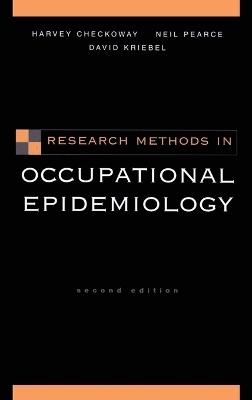
Research Methods in Occupational Epidemiology
Seiten
2004
|
2nd Revised edition
Oxford University Press Inc (Verlag)
978-0-19-509242-4 (ISBN)
Oxford University Press Inc (Verlag)
978-0-19-509242-4 (ISBN)
Provides a critical summary of research approaches to the epidemiological study of workplace hazards. This second edition provides discussions of methods such as case-cohort and case-crossover designs and statistical analysis of repeated measures data, a chapter on occupational health surveillance, and examples involving chronic health outcomes.
This widely used text provides a clear and critical summary of research approaches to the epidemiological study of workplace hazards. It describes the historical development of occupational epidemiology, methods for characterizing occupational exposures, and techniques for designing and implementing epidemiologic studies in this area. The relative strengths and limitations of various study designs for investigating specific health outcomes are emphasized. Also included are more advanced discussions of statistical analysis, exposure and dose modelling, and subsequent applications of data derived from epidemiologic research, as in meta-analysis, pooled analysis, and statistical analysis, exposure and dose modelling, and risk assessment. Since the first edition was published 15 years ago, there have been numerous advances in epidemiologic methods to accommodate a broadened scope of investigations of occupational exposures and associated adverse health outcomes. Thus, in this Second Edition the authors have updated their discussions of methodology to include such topics as case-cohort and case-crossover designs and statistical analysis of repeated measures data, and have expanded the examples they use throughout the book to demonstrate the applications of these methods to a wide range of acute and chronic health outcomes. They have also added a new chapter on occupational health surveillance. Their text is unique for its strong emphasis on the definition and assessment of exposures, the application of quantitative exposure data to epidemiologic models, and the recognition that improvements in workplace risk identification and quantification will come from careful integration of these approaches.
This widely used text provides a clear and critical summary of research approaches to the epidemiological study of workplace hazards. It describes the historical development of occupational epidemiology, methods for characterizing occupational exposures, and techniques for designing and implementing epidemiologic studies in this area. The relative strengths and limitations of various study designs for investigating specific health outcomes are emphasized. Also included are more advanced discussions of statistical analysis, exposure and dose modelling, and subsequent applications of data derived from epidemiologic research, as in meta-analysis, pooled analysis, and statistical analysis, exposure and dose modelling, and risk assessment. Since the first edition was published 15 years ago, there have been numerous advances in epidemiologic methods to accommodate a broadened scope of investigations of occupational exposures and associated adverse health outcomes. Thus, in this Second Edition the authors have updated their discussions of methodology to include such topics as case-cohort and case-crossover designs and statistical analysis of repeated measures data, and have expanded the examples they use throughout the book to demonstrate the applications of these methods to a wide range of acute and chronic health outcomes. They have also added a new chapter on occupational health surveillance. Their text is unique for its strong emphasis on the definition and assessment of exposures, the application of quantitative exposure data to epidemiologic models, and the recognition that improvements in workplace risk identification and quantification will come from careful integration of these approaches.
1. Introduction ; 2. Characterizing the workplace environment ; 3. Overview of study designs ; 4. Precision and validity in study design ; 5. Cohort studies ; 6. Case-control studies ; 7. Cross-sectional and repeated measure studies ; 8. Occupational health surveillance ; 9. Advanced statistical analysis ; 10. Exposure and dose modelling ; 11. Special applications of occupational epidemiology
| Erscheint lt. Verlag | 4.3.2004 |
|---|---|
| Reihe/Serie | Monographs in Epidemiology and Biostatistics |
| Zusatzinfo | numerous line figures |
| Verlagsort | New York |
| Sprache | englisch |
| Maße | 236 x 160 mm |
| Gewicht | 797 g |
| Themenwelt | Medizin / Pharmazie ► Medizinische Fachgebiete ► Arbeits- / Sozial- / Umweltmedizin |
| Studium ► Querschnittsbereiche ► Epidemiologie / Med. Biometrie | |
| ISBN-10 | 0-19-509242-2 / 0195092422 |
| ISBN-13 | 978-0-19-509242-4 / 9780195092424 |
| Zustand | Neuware |
| Haben Sie eine Frage zum Produkt? |
Mehr entdecken
aus dem Bereich
aus dem Bereich
ein überfälliges Gespräch zu einer Pandemie, die nicht die letzte …
Buch | Hardcover (2024)
Ullstein Buchverlage
24,99 €


